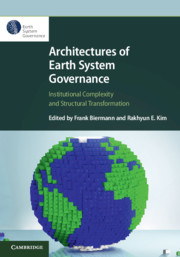Book contents
- Architectures of Earth System Governance
- Series page
- Architectures of Earth System Governance
- Copyright page
- Contents
- Contributors
- Acknowledgements
- 1 Architectures of Earth System Governance
- Part I The Building Blocks
- Part II Core Structural Features
- 6 Institutional Interlinkages
- 7 Regime Complexes
- 8 Governance Fragmentation
- Part III Policy Responses
- Part IV Future Directions
- Glossary
- Index
- References
6 - Institutional Interlinkages
from Part II - Core Structural Features
Published online by Cambridge University Press: 17 April 2020
- Architectures of Earth System Governance
- Series page
- Architectures of Earth System Governance
- Copyright page
- Contents
- Contributors
- Acknowledgements
- 1 Architectures of Earth System Governance
- Part I The Building Blocks
- Part II Core Structural Features
- 6 Institutional Interlinkages
- 7 Regime Complexes
- 8 Governance Fragmentation
- Part III Policy Responses
- Part IV Future Directions
- Glossary
- Index
- References
Summary
Given the regulatory gap in earth system governance, numerous new governance initiatives, such as multilateral clubs, private certification schemes and multi-stakeholder forums, have emerged to tackle transboundary environmental challenges. This plethora of different governance initiatives has led to a significant increase in the institutional complexity of global (environmental) policymaking and to more interlinkages between such institutions. Chapter 6 perceives dyadic institutional interlinkages as a key ‘microscopic’ structural feature of the overall global governance landscape and most basic building blocks or units of analysis in current scholarship on global governance architectures. After defining the term institutional interlinkages, we synthesize the literature on institutional interlinkages with a particular view on the expansion of interlinkages across different governance levels and scales. Against this backdrop, we examine to what extent the existing concepts and typologies of institutional interlinkages can capture the various new interlinkages between different kinds of institutions in earth system governance.
Keywords
- Type
- Chapter
- Information
- Architectures of Earth System GovernanceInstitutional Complexity and Structural Transformation, pp. 119 - 136Publisher: Cambridge University PressPrint publication year: 2020
References
- 10
- Cited by

